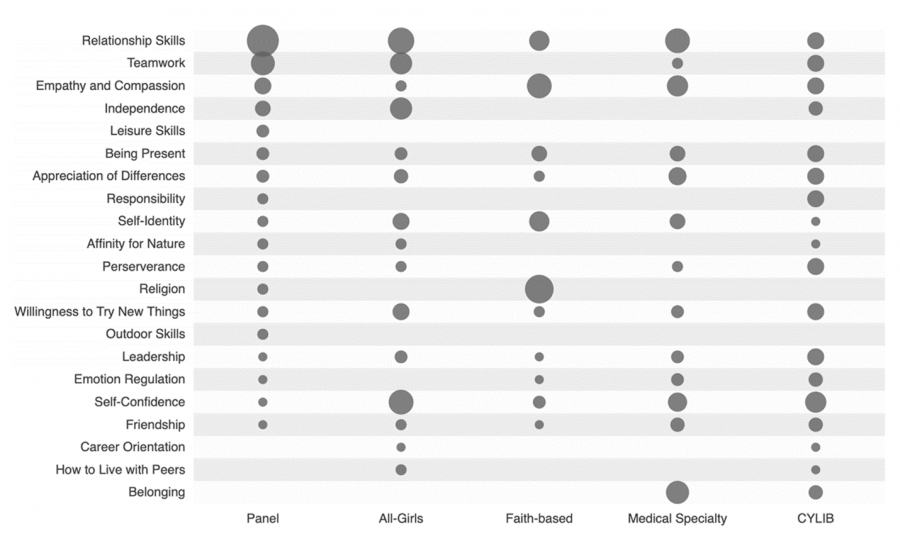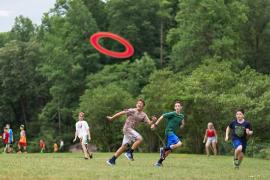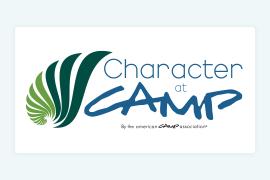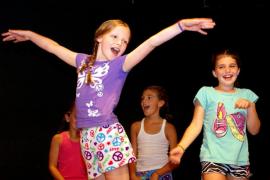Greetings camp friends!
We have an exciting new study to share with you called Similarities and Differences in Summer Camps: A Mixed Methods Study of Lasting Outcomes and Program Elements. In many ways, this study is a great way to celebrate the gifts of camp, not only because it reinforces what we know about the benefits of attending camp, but it does so in a uniquely collaborative way.
Some Background
ACA launched its National Camp Impact Study in 2016 to explore the lasting impacts of camp, and what happens at camp to promote outcomes that campers and staff go on to use in school, early jobs, and into adulthood. One of the first steps in this multi-year study was to survey camp alumni between the ages of 18-25 to see what they learned at camp and how they are using what they learned in their lives today. We sent this survey to a sample of camp alumni from ACA accredited camps as well as a sample of emerging adults in the general public—and the findings were nearly the same. The lasting outcomes of camp include relationship skills, independence and responsibility, appreciation for individual differences, and identity development.
Our goal with this phase of the study was to speak about camp broadly, so our sample included people that attended day camps, overnight camps, multiple years of camp, or just a few weeks of camp during their childhood. And while this approach was intentional, it did not allow us to say anything about specific or unique camp types.
Enter: Oversamples. To understand the lasting outcomes of camps with specific missions or populations, we needed to “oversample” participants who attended these camps as a child. So, in addition to our core, nationally representative sample, we collaborated with several organizations to collect additional data from alumni of their camps. These partners included Girl Scouts of the USA, Outdoor Ministries Connection, SeriousFun Children’s Network, and ACA’s Not-for-Profit Council, among others. The study we are sharing here represents the combined findings from these oversamples.
Similarities
Many of the outcomes we identified in our core national sample were identified by alumni from the unique camp types included in this study. These strongest of these outcomes include:
- independence
- perseverance
- willingness to try new things
- self-identity
- appreciation for differences
- appreciation for being present in the moment
Less strong, but still consistent across the camp types in this study were self-confidence, affinity for nature, relationship skills, and empathy and compassion. What does this mean? This study suggests that there is something distinct and foundational to what we call camp. The former campers in this study identified these as the lasting outcomes of their camp experiences, and also outcomes that they learned at camp more so, or in different ways, than in other developmental settings, like school. This does not necessarily mean that camp is better than these settings, but we can say that camp experiences — across different camp types and populations served — make important and distinct contributions to a young person’s learning landscape.
Differences
The differences we found across the different camp types suggest that, in addition to the outcomes we consider “core” to the camp experience, camps that have specific missions and camper populations foster additional outcomes.
Former campers who attended all-girl camps, for example reported their strongest and most long-lasting learning from camp included self-confidence, independence, and teamwork. One participant who attended an all-girl camp shared that:
Camp took me from an incredibly shy girl to who I am today. I am confident that I’m actually pretty cool, and a good person. I can be myself with anyone because I am no longer afraid of rejection. I am confident in myself, and I owe a great deal of that to the fact that I can do archery, cook some pretty great meals on a fire, build said fire in the rain, make any kid feel better when they are homesick, kayak, canoe, ride a horse, etc.
Campers who attended faith-based camp as a kid identified religion, empathy and compassion, self-identity, and relationships skills as the most important outcomes of their camp experiences. The faith-based camps in this study were aligned with Mainline Christian denominations, thus one participant shared:
I think the thing I learned that was most important is the utter and complete joy that can be found in Jesus Christ. A life with Christ is a life that can push through anything, celebrate with others, and also comfort others in sad times.
Participants who attended a medical specialty camp as a child shared that they learned relationships skills, a sense of belonging, empathy and compassion, and appreciation for differences as a result of attending camp.
The most valuable thing I learned at camp was how everyone deserves to be treated equal. A lot of times people treat us children with illnesses differently due to our conditions or just downgrade us. Camp has brought back the meaning of belonging somewhere in this world no matter how different or dysfunctional we seem to be. It’s a place where we do belong and we can be whoever and whatever we want to be.
The final camp type included in this study were camps that serve specifically youth from low-income backgrounds (referred to in this study as CYLIB). While most camps serve this population to some extent, we were interested in the unique outcomes when the camp’s mission and target population was exclusively young people who might not otherwise have the resources to attend camp. As described in the paper, this sample’s main developmental outcome was self-confidence. One participant indicated, “learning how to believe in myself and knowing that if I work hard I can achieve anything I want.”
Perhaps the best way to see the similarities and differences across the camp types included in this study is in the following visual. Across the bottom are the unique camp types, with “panel” representing the core national sample. The bubbles represent the strength of the outcomes that emerged from each sample. As you can see, the different camp types have a similar set of bubbles, it’s the size of the bubbles that varies from camp to camp, and in ways that you might expect.

The Most Exciting Part
Perhaps the most exciting thing about this study is that it was a collaborative effort. The authors each represent a different camp type or member of the research team. Not only do the findings represent the distinct and important outcomes of camp, but it highlights the ways specific camp types foster learning through their intentionally designed programs for their camper populations. In the spirit of the holiday season, this study is a perfect excuse to celebrate the diversity in our camp community and what binds us together: supporting young people and their growth.
So, in that spirit, I want to end by celebrating the collaborative process that culminating in this exciting research. Rob, Ann, and Jake shared a little about their experience with their project that I am so glad to share with you:
From Rob Warner, University of Utah research team and lead author: Writing can be a tiring process — write, read, delete, write, receive feedback, edit, repeat. In many cases, the revisions could go on forever. However, as with most things in life, doing difficult things gets easier when you tackle big tasks together. Without the collaborative process, this paper would likely still be unfinished and not nearly as polished. I’ve learned a lot about what we can do, which is a great reminder for all of us during these challenging times. A sincere thank you to all of my coauthors!
From Ann Gillard, SeriousFun Children’s Network: The process of understanding the results from this study and helping to write an article about it was helpful to my understanding of many things. First, I was honored to get to work with so many talented and dedicated camp researchers! Second, the results from this study specifically help us to hone and refine our understanding and language about the value of medical specialty camps, and other camps serving specific populations. We all think our camps do something special for kids — that's why we work so hard! This study helps us better understand the similarities and differences and motivates us to continue our work to serve campers from various specific populations.
From Jake Sorenson, Outdoor Ministries Connection: It was a privilege to collaborate with such a talented group of researchers from diverse camping backgrounds. This project served as confirmation that we hold core priorities and outcomes in common across the summer camp industry, along with affirmation of the unique gifts that specific camp types offer. Not only does camp in general matter, but specific priorities of individual camps also matter to both the camper experience and ongoing impacts.
Get your free copy now!
Want to read the full study? Access a free copy through February 5, 2021.
We hope you had the happiest of holidays, camp friends — we are grateful for you and the many ways you engage with camp research.
Photo courtesy of Kid City in Bloomington, Indiana
Laurie Browne, PhD, is the director of research at ACA. She specializes in ACA's Youth Outcomes Battery and supporting camps in their research and evaluation efforts. Prior to joining ACA, Laurie was an assistant professor in the Department of Recreation, Hospitality, and Parks Management at California State University-Chico. Laurie received her PhD from the University of Utah, where she studied youth development and research methods.
Thanks to our research partner, Redwoods.
Additional thanks goes to our research supporter, Chaco.
The views and opinions expressed by contributors are their own and do not necessarily reflect the views of the American Camp Association or ACA employees.




